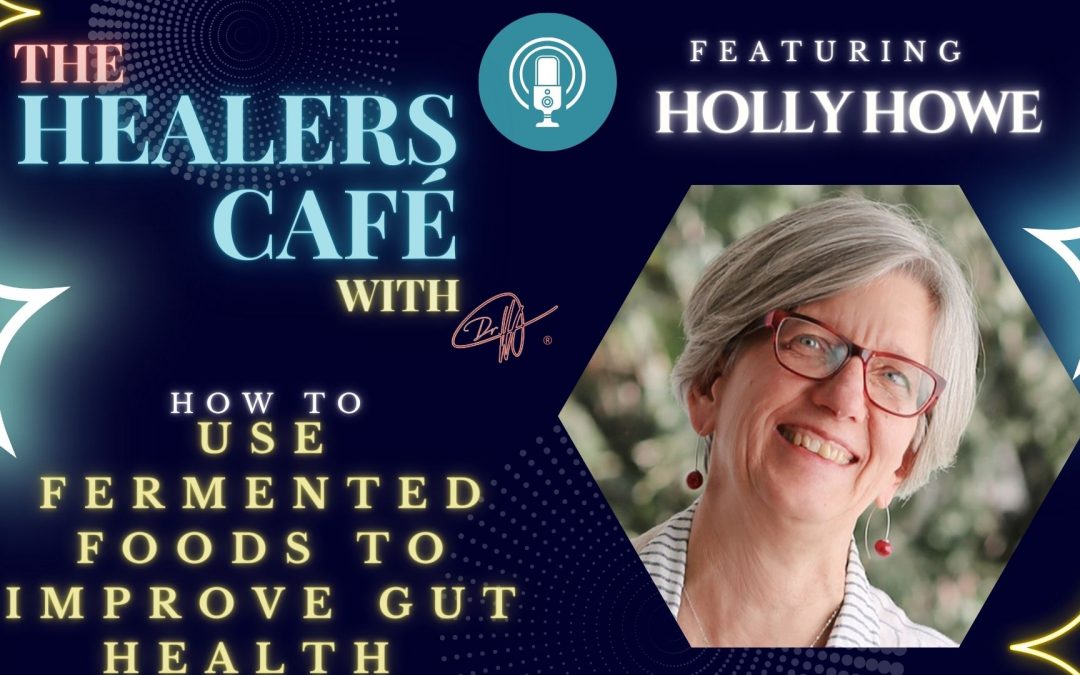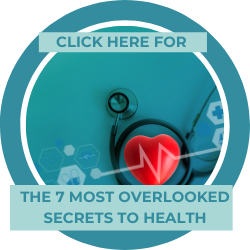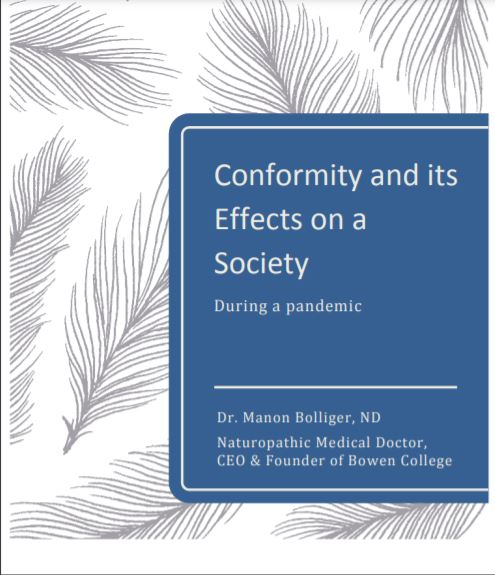How To Use Fermented Foods to Improve Gut Health with Holly Howe on The Healers Café with Manon Bolliger
In this episode of The Healers Café, Manon Bolliger (facilitator and retired naturopath with 30+ years of practice) speaks with with Holly Howe about learning to listen to my body and the messages it’s sending me. Realizing I have the power to create the radiant health I desire.
Highlights from today’s episode include:
Holly Howe So, a lot of people come for the gut health. And it definitely does make a huge difference because you’re providing your gut microbiome, with the food it needs to keep healthy to ward off invaders to keep pathogenic bacteria at bay, etc. So, all these things around improve gut health. It also helps with energy levels and helps with your serotonin levels.
Holly Howe if you’re having gut issues, generally, you want to start slow. Even sometimes people will start with just the brine. And then work your way up to one or two forkfuls a day with one or two meals. So, you can eat the whole jar if you have good digestive system. And it’s really, we don’t need all that it’s a condiment, we want to look more for a variety of different fermented foods versus downing the jar sauerkraut in one day.
– – – – –
Holly Howe you know, your doctors there for consulting, but you’re the one that’s coming in with what you need and asking for the help. And you have a lot of power.
ABOUT HOLLY HOWE:
Holly is the founder of makesauerkraut.com, a popular resource for online fermentation classes, recipes, and articles. A former grade school teacher, she helps students learn how to safely transform everyday vegetables into flavorful, gut-healing superfoods.
Core purpose/passion: To empower people to take back control of their health by learning to ferment gut-healing superfoods. to discover how to safely transform everyday vegetables into foods you love.
About Manon Bolliger
As a recently De-Registered board-certified naturopathic physician & in practice since 1992, I’ve seen an average of 150 patients per week and have helped people ranging from rural farmers in Nova Scotia to stressed out CEOs in Toronto to tri-athletes here in Vancouver.
My resolve to educate, empower and engage people to take charge of their own health is evident in my best-selling books: ‘What Patients Don’t Say if Doctors Don’t Ask: The Mindful Patient-Doctor Relationship’ and ‘A Healer in Every Household: Simple Solutions for Stress’. I also teach BowenFirst™ Therapy through Bowen College and hold transformational workshops to achieve these goals.
So, when I share with you that LISTENING to Your body is a game changer in the healing process, I am speaking from expertise and direct experience”.
Mission: A Healer in Every Household!
For more great information to go to her weekly blog: http://bowencollege.com/blog.
For tips on health & healing go to: https://www.drmanonbolliger.com/tips
SOCIAL MEDIA:
– Linktr.ee | Rumble | Gettr | Facebook | Instagram | LinkedIn | YouTube | Twitter |
About The Healers Café:
Manon’s show is the #1 show for medical practitioners and holistic healers to have heart to heart conversations about their day to day lives.
Follow us on social media! https://www.facebook.com/thehealerscafe
TRANSCRIPT
Welcome to the Healers Café. Conversations on health and healing with Manon Bolliger. A retired and deregistered naturopathic physician with 30 plus years of experience. Here, you will discover engaging and informative conversations between experienced healers, covering all aspects of healing, the personal journey, the journey of the practitioner, and the amazing possibilities for our own body, and spirit.
Manon Bolliger 00:42
Welcome to the Healers Cafe. And today I have with me Holly Howe. I hope I pronounced that properly.
Holly Howe 00:50
How, actually. Like Gordie Howe.
Manon Bolliger 00:54
That makes sense. All right. So Holly Howe, yes?
Holly Howe 01:00
Perfect.
Manon Bolliger 01:00
Okay. Otherwise known as the sauerkraut educator, I guess. Because we’re gonna be going through all kinds of information regarding the importance of it, how to, and even a recipe if we have time. So, my first question to you really is, how did you start down this path? I mean, obviously, it’s a health path. You don’t you know, do this without understanding the major benefits it has, but why had it start for you.
Holly Howe 01:43
I have always, thankfully grew up with good health and didn’t come to this with a health crisis trying to cure something. But just out of curiosity of how I could have the best health. I could, and stay active, healthy and mobile, till my, you know, into my 90s-100. Who knows. And so, I was always trying different health diets to the day. It wasn’t until about 20 years ago that I came across a book called Nourishing Traditions, by Sally Fallon. And it’s a book based upon what ancient cultures ate, and how those foods were prepared. And the man behind that is Weston A Price. And he was a dentist back in the 20s and 30s. And practicing and looking at the increasing rate of dental caries, and narrow mouth narrow palate, and was curious why all of a sudden were people’s teeth changing and what was impacting them. So, he went in search of communities cultures around the world looking for people with a with perfect teeth. And when he found these people with perfect teeth that were not sick, were not getting tuberculosis, which was common in that time. He then looked at their diets. They only found 14 groups, American Indians, Eskimos, anywhere around the world, Polynesians, Aborigines, and he looked he found these 14 groups, and he looked at what foods they were eating, and how they were prepared. And the one common food that went ran through these diets, among other things, was the inclusion of…
Read more...
fermented foods. So, every culture ate some type of fermented food. This is before we knew about the gut microbiome. These cultures just ate the foods because was part of their culture, part of their community had no idea how it was impacting their gut health, they just knew that it kept them healthy. And so that kind of was a lightbulb moment for me. And at that time, this was 20 years ago. There was very few books on fermentation out there. In fact, only two I could rely upon. There was no Amazon there was no YouTube. So, I built in and first bought my own sauerkraut Bubbies sauerkraut was a brand available then. And soon it got rather expensive to keep our family of four because we go through a jar in about a week. So, I decided I’d learn to make my own. So, I dived into Sally Fallon’s book and followed her recipe and use that as kind of the foundation and over the years fiddled around with things to improve the recipe. And it’s very different from when I first learned, but then started eating sauerkraut our family got rather tired of the first flavor I made, which was a cabbage and dill and then started experimenting with different flavors. A local farm here I went to do a demo at their place. And they gave me cabbage, carrots and garlic. That’s all that they had available at that time. And I threw those together and that became my first kind of flavorful recipe. And since then, I’ve had a lot of fun creating recipes to meet the different palettes in the family and keep everybody happy and realize how many ingredients you can put in sauerkraut and how much fun you can have with it.
Manon Bolliger 04:58
Okay, well.
Holly Howe 05:01
So yeah, the idea that healthy traditional communities ate fermented foods.
Manon Bolliger 05:06
Yeah. So, tell us the benefits that I mean, one that you’ve seen directly in your family, but also obviously that, then, you know, yeah, well, why should people be eating fermented foods?
Holly Howe 05:24
Right. Well, that’s the one. The one question I always ask my readers once they subscribe to my newsletter is why are you interested in learning to fermented foods, and the number one reason everybody gives us for gut health. So fermented foods do provide probiotics and prebiotics to help with our gut, keep our gut lining in tack and just help with transit time, etc. So, a lot of people come for the gut health. And it definitely does make a huge difference because you’re providing your gut microbiome, with the food it needs to keep healthy to ward off invaders to keep pathogenic bacteria at bay, etc. So, all these things around improve gut health. It also helps with energy levels and helps with your serotonin levels. Vitamin C, the nutrients. If you look at raw cabbage, and you were to look at the vitamin C content of raw cabbage, it’s about 30 milligrams, fermented that same green cabbage, the fermentation process unlocks these nutrients. Vitamin C is more available, they call it bioavailable, so we’re able to eat that same cabbage through the fermentation process, there’s more vitamin C in it. So that 30 milligrams of vitamin C in green cabbage is now almost 60 milligrams once fermented. If you take red cabbage with the poly phenols, and that nice, beautiful red color that has so many more nutrients, that hops up to 600 milligrams per one cup serving. So, 695. So, it’s just amazing what that fermentation process can do to the nutrients. As we age, our hydrochloric acid levels go way down. And through the fermentation process, lactic acid is produced, lactic acid serves as a digestive aid. So just all sorts of things that can help us along the way.
Manon Bolliger 07:26
So, do you typically suggest people have it sort of at the start of the meal to like, or before the meal kind of thing? Or do you just it doesn’t, it all works out taking it during the meal,
Holly Howe 07:40
You know, there has been people have gone in and looked at that. And I don’t worry about it to me, we’re eating the food. And that’s if we can just get people including a new food in their diet. That’s a huge win. And so, I don’t get specific about it. And it’s just when people first find fermented foods and make the first jar of sauerkraut, their body will be telling them that they need this food. That’s what the gut microbiome, the bacteria in your gut are saying, we need this food, eat it. And all of a sudden, they’re craving it and they just they can eat to the bottom of that jar in one sitting. And we have to be careful with that. It is a condiment. And for people who are dealing with digestive issues already, that can be an influx of way too much bacteria, you can end up with just the very thing you’re trying to prevent by eating sauerkraut. So, if you’re having gut issues, generally, you want to start slow. Even sometimes people will start with just the brine. And then work your way up to one or two forkfuls a day with one or two meals. So, you can eat the whole jar if you have good digestive system. And it’s really, we don’t need all that it’s a condiment, we want to look more for a variety of different fermented foods versus downing the jar sauerkraut in one day.
Manon Bolliger 09:00
What about people with like yeast overgrowth, which is often ultimately a gut issue, but often they’re told oh you can’t have any fermented foods you can have, you know, vinegar you can’t have…. What do you do with that? or what have you found?
Holly Howe 09:21
I’m an educator, not a medical practitioner. So, I’d be careful that I can’t prescribe anything. But one other gal I follow on the internet has done a lot of research and delves more into the health issues and she sees no connection with the Candida, and it being a problem eating fermented foods. And I just go back to listen to your body. We have little angel messengers all the time giving us feedback. And when we introduce a new food like this, to take it slowly and see what happens to the symptoms we’re concerned about. And you know, it’s not a magic bullet. It’s part of a comprehensive diet. It’s just one component of it. It’s not like a fermented foods diet, we’re just adding a condiment to our plate, we’re adding a fork full of sauerkraut to our salad to make the flavors pop. When we put that hamburger together that hot dog, we add the fermented food to it. And the flavor shift and change and everything tastes so much better. So, when we’re looking at specific health concerns, take it slow and listen to your body and have just a sip of the brine for a week and see how things shift or change. And if everything’s good, then we try a few strands of the sauerkraut and then work your way up to that. The serving size.
Manon Bolliger 10:41
Yeah, I didn’t officially know what the official answer is. But I don’t do anything that way anyways. It just seemed that it would really make sense provided you’re listening to your body, because thts the only thing you can do anyways. You know, if your body is it seems to be reacting, maybe there is something that you have to wait through. Right. But otherwise, yeah, slowly but surely.
Holly Howe 11:15
Yeah, we’re taking care or gut microbiome. Hippocrates said that is the root of all illness is back to the gut microbiome and the research on that did not start till about I think it’s 15 years ago now. And it’s fascinating what we’re learning and learning how many different bacteria are out there and bacteria are everywhere we live with them. It’s a relationship. We don’t have to fear them. They’re our friends, they support us. They take care of our health. And it’s just by eating the fermented foods, it’s just one more thing to take care of your gut microbiome. And when your gut microbiome is healthy, then your whole health can shift.
Manon Bolliger 11:55
Yeah, exactly. Well, how about a recipe?
Holly Howe 12:00
A recipe, okay.
Manon Bolliger 12:02
Something like, you know, that if people are listening, as well, I mean, you have notes to share. So, people who are watching this on rumble, or YouTube can watch the notes as well, but we’ll do both.
Holly Howe 12:17
So excellent. And yeah, and so when we think of making a food like this, and making sauerkraut, it’s a recipe out there. And it’s a way of working with the bacteria, the bacteria that are actually on our hands, on our face, all different groups of them, they live everywhere, and they live on the vegetables that we’re fermenting. And so, we are setting up a home for these bacteria, so they can do the work that we need. We don’t have to ferment, we just have to provide the home for them, and then they do the work for us. And just like any recipe, we have certain tools we need, etc. So, I’ll start with that and keep it kind of high level, I’m going to share my screen and let you know what’s on the screen for the people listening.
Manon Bolliger 13:03
Okay.
Holly Howe 13:07
So, what I have here are the tools and ingredients. The recipe I like to start people with is called Sweet garlic sauerkraut. And that’s going back to that farm where they handed me carrots and garlic and cabbage and said let’s make sauerkraut with that. And when we’re learning to ferment a mason jar is really all you need to pack everything into and then salt to give the bacteria the right home and to help feed them. And then a scale just like we would use measuring cups and measuring spoons to make a batch of cookies, we’re going to use a scale to make sure we have the right amount of cabbage and ingredients and the right amount of salt. The bacteria that help make fermentation happen. They love a set amount of salt in there too much salt, they slow down and don’t work too much. Not enough salt than the pathogenic bacteria or molds and things like that can happen. So, we use a couple carrots and a few cloves of garlic. And I call those my flavoring ingredients and the carrots get shredded and the garlic gets chopped and those go into my bowl first because I’m going to flavor my sauerkraut with that and then I’m going to add all the cabbage until I have just enough cabbage that once mixed with salt will fit into my jar properly so you can adjust these recipes. But again, we work with our flavoring ingredients put into the jar and then we add the cabbage on top of that. So, I’ve shredded my carrots and chopped my garlic and then I’m going to put them into my bowl. And it’s a large mixing bowl that I can put my hands into and we’re like making a batch of coleslaw. It’s very similar to that. I thinly sliced my cabbage, and you want to thinly slice the cabbage because the idea is we want to open up all the little cells inside slices of cabbage to let the water out. That water’s going to combine with salt to create a brine. So, add enough cabbage in this recipe and the recipe I have on my website, it’s 800 grams. That’s the amount that will fit into my jar. So that’s the weight of my carrots, my garlic and my cabbage.
Manon Bolliger 15:22
All together?
Holly Howe 15:22
Yeah, all together. And then we’re going to sprinkle in a tablespoon of salt and mix that nice and thoroughly together. And what I like people to do is just actually mix in that salt. So, here’s my hands in the bowl, and you see the beautiful shreds of carrots mixed in with the thinly sliced cabbage, we mix it all together so that the salt could spread throughout and the salt can work to pull out the water to create a salty brine and we need that salty brine. Because the bacteria for fermenting vegetables are anaerobic, those bacteria do not like air, they want to be sunk down below the brine where they can do their work. So, we need a brine to hide them down to keep them away from the air. So generally, what I do is I’m mixing all that salt, you’ll see a lot of recipes, where they tell you to pound the cabbage and work at it to get your brine. If you let the magic of osmosis work for you, you can pretty much let this sit for like 15 to 20 minutes, and then come back and kind of squeeze the cabbage a little bit and you’ll notice that you have your brain and during that 1520 minutes you clean up your kitchen, you put your mess away and get to come back to this beautiful last step in your artwork.
Commercial Break 15:35
Manon Bolliger here and I want to thank you for taking actionable steps towards engaging your healing journey, and helping others discover their path by watching, sharing, subscribing, and reviewing these podcasts. Every review and share helps spread the word these different perspectives and choices and options for healing. And to thank you I’d like to invite you to sign up to my free seven sequence email tips on health and healing for everyday life. You can go to healerscafe.com tips, thanks so much.
Holly Howe 17:18
Of packing everything into the jar. So, you’ll see in this picture, I have a jar with a handful of wet juicy dripping sauerkraut is dripping with brine the bottom of the bowl, you can see kind of a orangey liquid, that’s the coloring from the carrots and the liquid from the cabbage cells. And that’s the brine that we need. So, we packed that all into the jar, and you would never have guessed that that big bowl full of sliced cabbage will fit into a jar, but it does. And then once it’s pressed down in there, you’ll see all the brine rise to the surface. So, we’re looking at the top of the jar right now my fingers are down in there, packing everything in. I put what’s called a floaty strap on top, which is a piece of cabbage leaf cut into a circle about the size of the jar. And that prevents little bits from floating to the surface. Things that sit on the surface can attract they act like a little lily pad and can contract attract the mold spores. So, you try to keep as much as possible everything below the brine. And this next picture is three jars one where I’m putting the little cabbage leaf in and then a little jar, this can be like a shot class. Or if you don’t have a little jar, you can use something heavy in there or another drawer maybe filled with water with the lid on, you’re trying to come up with some type of weight to hold everything below the brine. I like people to use what they have around the house initially, and not feel they have to go out and buy a bunch of fermentation equipment. That’s fun to do down the road. But initially, if you learn to work with what to have, and learn how this whole process works, then it’s intuitive and you almost know what you need then, and you have lots of tips. But ideally, I’d like people to start with what they have around the home. So, I use these little jars. And then the third picture is I’m putting the lid on, and the brine is rising to the surface. And that’s because the little jars pressing down on what’s packed in the jar and forcing that Brian to the surface. And that’s pretty much it. We let that sit on our counter to ferment anywhere from seven to 21 days. And then you have delicious sauerkraut to enjoy. So, there’s a picture here of someone about to eat a delicious bite of sauerkraut. It’s making me hungry. Exactly just what your body needs.
Manon Bolliger 19:49
So, what have you fermented? Like what’s the I mean, that looks great. And cabbage is probably one of the most common things that people ferment. But what else can you ferment in this way?
Holly Howe 20:04
So, this is a vegetable ferment, so you would pretty much ferment just about anything. Cabbage is what we call a dry ferment, meaning that we don’t add a brine to it, we allow the salt to pull the liquid out to create its own brine. You think pickles, you know, mainly like cucumber, pickles or any other vegetable that you want to ferment, those are in larger chunks, and there’s not the liquid that you’re going to pull out of them. So, they’re fermented in a brine, but still a similar process, using the right amount of salt correctly chopping up your vegetables and letting them sit under the brine. for X number of days, usually the vegetables ferment for a shorter time. But those are the vegetables that can be fermented. But you can you know; dairy is a way of is a ferment. It’s usually a cultured ferment where you’re adding a culture to it to ferment. Kombucha is a ferment I mean, anything out there can be fermented, you just kind of learn the rules of it. But I really like starting people with sauerkraut, because it is number one, so easy to do, you generally can get away with fermenting any time of year. Technically, fermentation as a means of preserving foods. In ancient cultures, they would preserve all their cabbage in the late fall, when that cabbage was picked. They wouldn’t be sitting down in June with a head of cabbage that had been sitting in their cellar for six months and trying to ferment it. But we are welcoming people into this to learn this new act, this new skill of preservation. So, if you’re trying to, to preserve cabbage in the middle of June, it might be a little bit more challenging, but it can be done. So, it’s a method of preservation of our vegetables that are made generally it was done seasonally, but I’m forget where I was going. But yeah, lots of things can be fermented. And they all with sauerkraut is so such a wonderful ferment to start with, because it’s teeming with all this different bacteria. It’s so easy to add to any meal, you can put it on your eggs in the morning, you can mix it into a smoothie where you can almost hide it, if you’re trying to introduce that to somebody, you can add it to a salad, you can eat it just alongside any meal. So, it’s a wonderful ferment to start with.
Manon Bolliger 22:27
And the saltier like, I mean, it seems so relaxed and easy, and you were just doing it. But you’re not like the salt has a certain amount that you need for a ferment.
Holly Howe 22:43
So, we’re weighing things in my recipes are set up, we call it 2% salt concentration, okay, and that is 800 grams of the sauerkraut cabbage mixture, and one tablespoon of salt. So, happens to be approximately 16 grams. So that’s your 2%. You can get away with like people who are concerned about too much sodium in their diet, they can drop it down to 1.5%. And you can go up to 2.5%, which generally if it’s really warm weather, you can use more salt to slow things down. If it’s very cold weather, you can use less salt to speed things up. But you generally want to be in that range. And that’s because microbiologist have looked at fermentation and what grows and what happens. And now they have found that range to work the best. So, all my recipes are set up for success with that correct amount of salt in there.
Manon Bolliger 23:39
Okay, so I did notice because I’ve signed up for it. You have a book about or like a pamphlet that explains the seven things that you should be careful about.
Holly Howe 23:55
Yes. So those are seven fermentation mistakes. That’s like the main opt in on my website if you go to makesauerkraut.com. And it’s just the common things that people mistakes, people happen. It’s really a great introduction to fermentation. And what to learn it’s one is like fearing the bacteria. People are so afraid of these friends. I mean, just think of that we can pack cabbage into a jar with some salt. And it magically transforms I mean, that just kind of blows me away that that’s happening in that jar. And so, people can fear the bacteria and they want to use hand sanitizers that they want to scrub their cabbage down or bleach it or bleach their countertops, or bleach their jars, etc. And during that whole process, we’re killing off all the bacteria that we need for that fermentation process. So that’s like to me one of the benefits of fermentation is you’re being introduced to this whole new world. You’re developing a larger community, the microscopic community, and then also the community of your friends that you share this with and turn them on to this. And then the community of your farmers out there that grow the cabbage for you, because ideally, and this was like a 10-year process for me to get to this point. But ideally, you’re either growing your cabbage yourself, or you’re finding a local farmer, that grows it for you from your local farmers market, because then it’s almost impossible to fail with this because those bacteria are they’re just ready teeming, they haven’t been shipped around the world. And so that’s that benefit of fermentation that’s opened up for me. It’s not just like the gut health. It’s the community I’m connected with. It’s the cultures when I learned to make kimchi and learn about the wonderful Kim Jong season, they have every November where hundreds of women are on the plaza, making kimchi to give away to the needy. It’s part of their culture. And these ferments open up so much to you. The first kombucha I had which I don’t didn’t realize I would look back on it. I was traveling through Russia back in the 80s in my 20s, and jumped off the tour because I don’t like doing tours. And we entered down these little side streets and met this elderly lady, she that invited me into her home to have this fermented tea. And that was kind of my first taste of kombucha connected to this culture.
Manon Bolliger 26:31
Right. Yeah, I think it does open, you know, when you look at the microcosm. Larger, you know, how we’re related to everything. Yeah, I mean, we’re all we’re all so connected, right, and the foods we can enjoy from that same perspective, rather than, you know, the, I guess, the dominant, but I think it’s a disappearing culture of, you know, fighting everything we have and fighting the enemy without exactly, you know, and looking at ourselves as somehow, you know, incomplete, inept, or missing, you know,
Holly Howe 27:16
Really interesting ingredients. Yeah, the future, but even viruses, how they work with us and how they’re there to protect us. And, yeah, that’s a pretty amazing world out there.
Manon Bolliger 27:28
Yeah, I think it’s, I think a lot of people are waking up to the need for this.
Holly Howe 27:36
Exactly.
Manon Bolliger 27:37
Of the unbelievable abuse of, you know, what has happened in the last three years. I think it’s…I don’t think that part was by design. Except for if you know, you give a design to, to greater forces, then, then those who think they can, you know, control the future. But I think, yeah, it’s really the time to take charge of our health.
Holly Howe 28:06
Exactly and that’s what a lot of people learn to make sourdough bread learn to can learn to ferment for the first time, over the last few years, there was a run-on canning jars, you could not get the other jars that most people are learning to ferment, and because they’re just the supply was gone. And it just became, to me such an empowering process, like you say, to take charge of your health, there’s one little thing you can learn to do. And that’s kind of like kind of my underlying philosophy of life, etc., that we can take charge of our health and start with one jar of sauerkraut start with one bite of it and see how it changes things. And, you know, your doctors there for consulting, but you’re the one that’s coming in with what you need and asking for the help. And you have a lot of power.
Manon Bolliger 28:57
Definitely. Well, I and I don’t know that the way that medical doctors are trained. It’s really about disease management.
Holly Howe 29:09
get a number and you get a code, the diagnosis code and then that’s what these are the things I can do for you under that code. So instead get some cabbage and bacteria and…
Manon Bolliger 29:23
Do what’s right for your body and you may not need any other help.
Holly Howe 29:28
Exactly.
Manon Bolliger 29:30
Anyway, it was lovely having you and thanks very much.
Holly Howe 29:35
All right, great.
ENDING: 41:33
Thank you for joining us at the Healers Café with Manon Bolliger. Continue your healing journey by visiting TheHealersCafe.com and her website and discover how to listen to your body and reboot optimal health or DrManonBolliger.com/tips.






